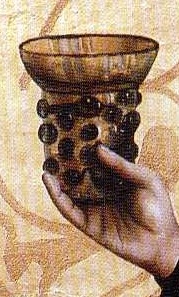Nuppenbecher

Nuppbecher , also known as nub beaker , is the name of a common drinking glass shape of the high and late Middle Ages . Most of the known specimens date from the 13th and 14th centuries.
The distinctive feature of the tumbler cups are numerous, mostly relatively small knobs on the vessel wall. The vessel body covered with these nubs is often cylindrical or slightly conical. The edge, which is often set off by a thread, is usually undecorated.
Colorless cups of this kind were probably produced in Venice , Bohemia and southern France , possibly also in glassworks in Germany . A variant made of light green glass with small, often snail-shaped protruding nubs ( Schaffhausen type ), which occurs mainly in northern Switzerland , southern and western Germany and as far as Alsace , apparently mostly comes from local workshops. A late form of Nuppenglases with larger prunts is the Krautstrunk .
Nuppenbecher were not only made of glass , a silver specimen comes from a depot in Lingenfeld .
The coat of arms of the Counts of Küssenberg shows a knobbed glass. The same applies to the Escher vom Glas family from Zurich .
literature
- Erwin Baumgartner, Ingeborg Krueger (Ed.): Phoenix made of sand and ash. Medieval glass. Klinkhardt u. Biermann, Munich 1988, ISBN 3-7814-0280-0 , p. 192 ff. (Exhibition catalog Bonn 1988, Basel 1988).
